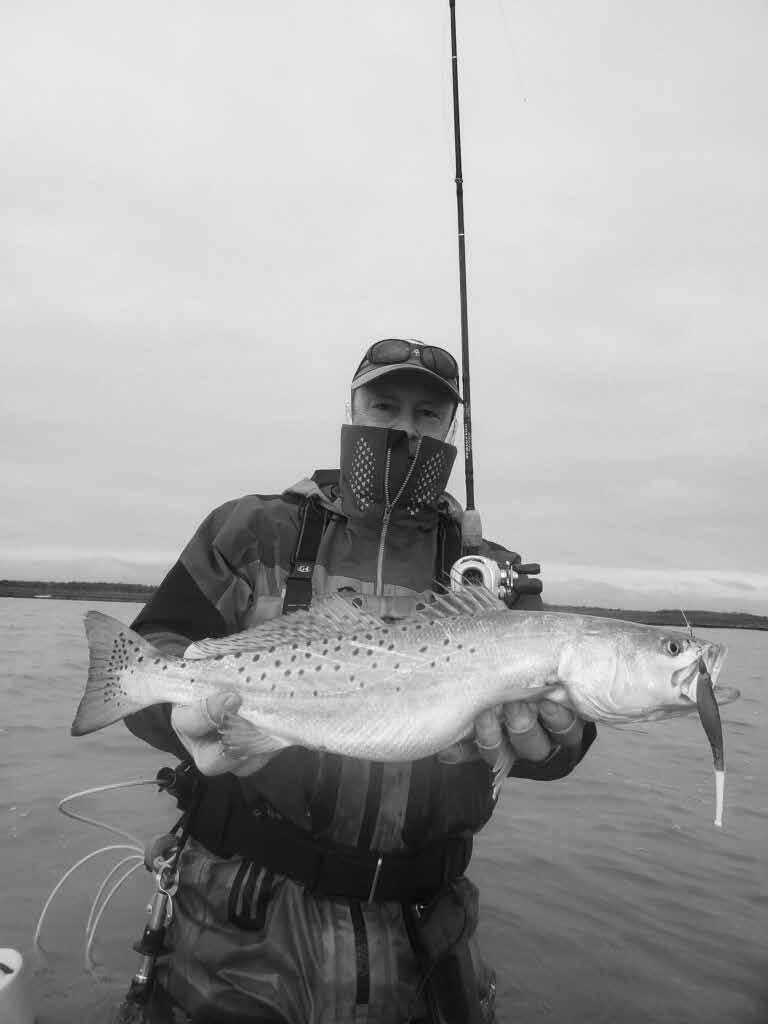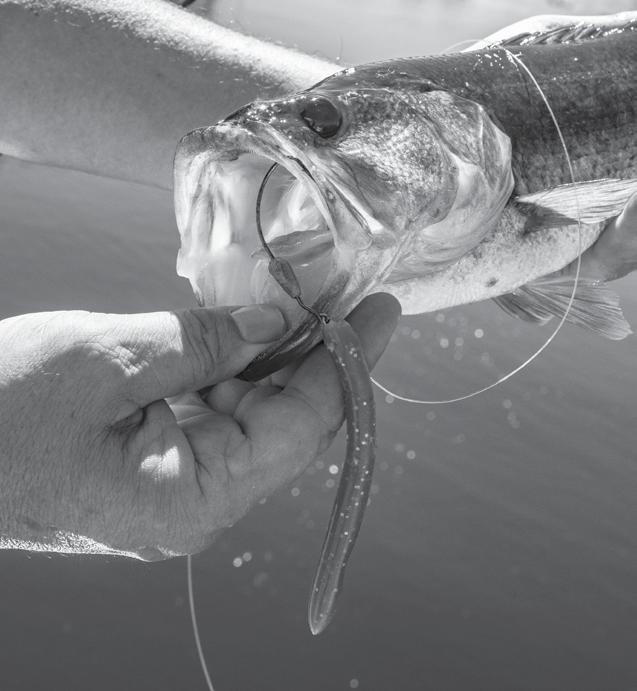
13 minute read
Game Warden Blotter
BAITING FOR DUCKS
Liberty County game wardens wrapped up an investigation that included surveillance on an area that had been heavily baited for waterfowl. The wardens contacted a group of five hunters, one of whom admitted to placing the bait, and found them to be in possession of 31 ducks. All ducks were seized and charges were filed.
Advertisement
JOINT EFFORT ON SOUTHERN COAST
Texas game wardens assigned to the Marine Tactical Operations Group completed a two-day joint patrol with United State Coast Guard Station South Padre, focused on the Gulf of Mexico and the coastal waters of the Rio Grande River. The patrol resulted in the seizure of multiple illegal fishing gear and the release of numerous species caught on such gear.
REWARD FOR POACHERS OF TAGGED DEER
During a 7-day period from Oct. 25-Nov. 1, three white-tailed bucks disappeared from the LHK Ranch in Berclair, Goliad County. The three deer were all tagged, one with a red tag in the right ear, one with a black tag in the left, and the third with a green tag in the right ear. All three bucks measured around 200 inches. An Operation Game Thief reward is available for information
DREAM TRIP FOR YOUNGSTER BATTLING CANCER
A Calhoun County game warden and trooper made a dream come true for a young man who has been battling a rare form of pediatric cancer since 2017. The 16 year old has been living in Houston for treatment. From Alabama, he loves everything about the outdoors. One of his wishes was to have the opportunity to go on a duck hunt by airboat. The dream came true when he rode shotgun in the front of an airboat with his father and two close friends for a youth hunt. A few redheads were bagged.
leading to the indentification, arrest and convection of the person(s) responsible.
NO FISHING LICENSES, PLENTY OF BIG BLACK DRUM
Jefferson County game wardens checked two fisherman who were found to be fishing without a valid Texas fishing license. The fishermen were in possession of 27 black drum, 20 of which were oversized. All fish were seized and donated. Cases and restitution pending.
OPERATION HALF SHELL RACKS UP CASES
Between Dec. 14 and 18, Calhoun and Aransas County game wardens led a multi-agency law enforcement surge operation targeting illegal commercial oyster harvest and possession along the Coastal Bend. “Operation Half Shell” consisted of patrols by wardens in collaboration with the U.S. Coast Guard, Calhoun County Sherriff’s Office and the Aransas County Sheriff’s Office. The operation resulted in more than 70 criminal cases and numerous warnings over four days. In total, 436 sacks of oysters, approximately 47,960 pounds, were returned to the bay. Many of the violations were for possession of undersize oysters that the state’s reef ecosystems require for sustainability and for future harvests. Wardens made 12 arrests for possession of undersized oysters from oystermen who had two prior convictions on the same violation. Game wardens also issued 42 citations for possession of undersize oysters, adding up to 34 percent of the cases. Other arrests included unlawfully selling molluscan shellfish and possession of marijuana.
WARDENS HELP AFTER BIG SNOWSTORM IN TRANS PECOS
Texas game wardens, as part of the state’s emergency response team, coordinated through the Texas Department of Emergency Management, assisted with the impacts from severe weather over a large portion of the state, including Sterling County game wardens, who assisted with a jackknifed tractor trailer and helped a local rancher after a motorist went through his fence, and a Terrell County warden who assisted a family that went off the road.
TRAFFIC STOP LEADS TO DISCOVERY OF DRUG STASH
A Webb County game warden, at a traffic stop, called for assistance from other wardens after suspecting drug activity. The driver gave consent to search the vehicle. The wardens found substances believed to be heroin, crack cocaine, Xanax pills and drug paraphernalia. The driver of the vehicle was arrested and transported to the Webb County Jail. The other two occupants were cited and released. All charges are pending.
REPORT ILLEGAL HUNTING AND FISHING ACTIVITY FOR A REWARD OF UP TO $1,000. CALL OPERATION GAME THIEF AT (800) 792-4263
AN AMERICAN LEGEND
Rolling Plains quail
Continued from page 1
said. “Rick is using one feeder for every 300 acres and feeds (the medicated feed) only two times per year (in March and in early fall).”
Based on his firsthand observations, Crafton feels the Photo from Joe Crafton medicated feed is working.
Awaiting approval for the medicated feed from the Federal Drug Administration has been a long process, now going on six years. Dr. Kendall’s staff is documenting the findings to support the application to the FDA.
Snipes said he estimates the ranch has about three times the numbers of birds it had last year.
Dr. Dale Rollins, executive director of the Rolling Plains Quail Research Ranch, said in his monthly newsletter there is some more “good” news on the quail front.
“Our November helicopter counts were up 15 percent and our trapping-banding effort showed a 20 percent increase,” he said.
While hunting reports from the Rolling Plains weren’t great, a good rainfall year could help the numbers rebound.
At the Matador Wildlife Management Area, Manager Chip Ruthven said hunters with good dogs have been “pleasantly surprised.”
In Fisher County, Paul Melton said this season has been an improvement from last year, saying bird numbers are 35 to 40 percent higher.
RUGER.COM/AMERICANRIFLE

Port M specks
Continued from page 8
the lower 60s, and the guides said that’s pretty much where it’ll stay throughout the winter months.
“The exception will be when cold fronts move through and lower the water temperatures a few degrees for a couple of days,” Sauls said.
When it comes to catching cold water trout, Sauls said three of his top lures are a Kelly Wigglers with a willow tail, a 6-inch Hogie paddle tail and a suspending bait like a Paul Brown’s Soft-Dine XL. His go-to colors are purple, chartreuse, jalapeno pepper and Mansfield margarita. With the Hogie paddle tail jig he’ll opt for one that is green and brown with a white tail. With the SoftDine, silver with a black back is the slow sinker he prefers. But he’ll also fish an Original Corky in black, pink or red/white.
“That green and brown Hogie paddle tail is the ugliest lure I’ve ever seen,” Sauls said. “But it catches Photo by Capt. Ruben Garza big trout. Usually, I’ll fish the lures with a slow twitching retrieve, kind of like a walk-the-dog action. On sunny days I’ll often speed up my retrieve with soft plastics.”
Ruben Garza Jr. has been fishing the Laguna Madre out of Mansfield for decades. His personal best trout measured 30-3/4 inches. That trout was caught on a Kelly Wigglers ball tail, one of Garza’s go-to lures for winter trout. His top colors are Mansfield margarita, Getaway jalapeño pepper, and green with a white tail.
Garza said the best areas to get the most bites will be over grass or potholes.
“The main thing is to look for mullet,” he said. “Just one single mullet can often be the key to catching a big trout. Usually when a mullet jumps out of the water it’s being chased by something. Right now I’ll be wading in waist-deep water just about every day, with mid-morning to mid-afternoon being the prime hours to be on the water. We’re doing lots of wading now, but we’ll also do some drift fishing. It’s always good to fish areas with close access to deep water.”
One thing to keep in mind is to move slowly and be on point with every cast.
Both Garza and Sauls spool their reels with 20- to 30-pound test PowerPro braided line and 20-inch Fluorocarbon leaders.




LSONews com LoneOStar Outdoor News January 8, 2021 Page 13 Winter largemouths Stripers on place.” Continued from page 1 shad
Dodd said smaller bait presentations used Continued from page 8 on drop-shot rigs have been working well, along with wacky worms. Natural colored baits under 5 inches in length have been his choice. “Suspending jerk baits have also been producing consistently for us lately,” he said. “My bread-and-butter has been focusing on points and drop-offs with cover. A lot of the fish are suspended near these areas.” An average day is producing 10-20 bass, depending on the skill level of the anglers Dodd has been guiding. “There has been a lot of bass schooling off of points and the edges of creek channels chasing small fry,” he said. “You just have to throw small baits to catch them.” Caddo Lake guide, Paul Keith, said the bass bite has been extremely hit-and-miss. “One day you’ll go catch a mess of really nice fish, and the next day you’ll go back to the same exact spot and they won’t bite,” Keith explained. “It’s been a little perplexing. They’re feeding patterns have just not been consistent.” On the days the fish have been willing to feed, Keith said he’s been catching plenty of bass between 4 and 8 pounds. “There’s a lot of chunky fish to be caught right now, it’s just about whether or not they will cooperate ,” he said. “The early morning hours have rendered the most action.” Keith said there have been some bass schooling sporadically on the flats adjacent to nearby creeks in 2-4 feet of water. Lipless crankbaits and chatterbaits have been the ticket when the fish are found schooling. Fishing guide Kenneth Morris said the bass on O.H. Ivie have been holding in deep water from 18-24 feet. “Points, rock banks, and drop-offs have been holding the most fish,” Morris said. “Vertical presentations have been the most effective. I’ve been using Senkos with a 1/2-ounce weight.” Square-billed crankbaits also have been producing strikes when anglers are targeting rock banks. “The average size of fish on O.H. Ivie has been pretty good lately,” Morris said. “I caught nine bass the other day and only one was under 18 inches long. Most of the fish we are catching right now are in the 3- to 5-pound range, and every now and then someone catches an 8- or 9-pounder.” On Lake Travis, guide Bryan Cotter said the best action is coming from Texas-rigged soft plastics in watermelon and green/pumpkin colors. “Creature baits and craw worms are also doing the trick right now,” Cotter said. “The top-water bite has been decent early in the mornings around deep drops close to the shore. Crankbaits worked around the edges of ledges are also producing plenty of strikes.” Photo by Nate Skinner, for Lone Star Outdoor News The guide said finding shad to net can be difficult in winter. “They are usually easy to catch with a cast net,” he said. “But there are days when they can be scarce. Most of the time I’ll be on the lake at about 4 a.m. to catch enough shad for a day of fishing. They can often be found under the lights on piers and boat docks. When a front moves through, the big schools of shad will move to deeper water. But within a day or two after a front we’ll find them in the coves.” The lake is currently 5 to 6 feet low. “That’s just right for winter fishing,” Williamson said. Williamson uses his electronics to find the shad in the treetops. “The shad are suspending in the treetops and that’s where we’ll find most of the stripers,” he said. “I’ll also use topographic maps that show humps and ridges. One of the best winter patterns is to work the treetops in water that’s around 60 feet deep. For example, if I’m fishing a tree in 60 feet of water the shad and stripers could be suspended in the treetop anywhere from 20 to 40 feet deep.” The key to finding stripers and catching them is to use the right size of shad. Some days the stripers will prefer a shad that’s 2 inches long. On other days, they will be on 4-inchers. “One of my go-to shad fishing tactics is to use a Carolina rig,” Williamson said. “I’ll use a 3-foot, 20-pound test monofilament leader. Above the leader I’ll have a 1-ounce weight. I like to use a No. 2 Kahle hook. To keep the shad alive I’ll slip the hook through the nose of the bait to keep it alive longer. You want to use a weight that’s heavy enough to keep the shad on bottom or near the structure. If you don’t use enough weight the shad will swim towards the surface and away from the stripers.” Another tactic the guide uses is to anchor his 25-foot Boston Whaler and fish six to eight rods with live shad in water that’s 18 to 20 feet deep. That’s when he’ll be fishing over humps and ridges. “The trick is to fish the shad about 3 feet off bottom,” Williamson said.
THE T E X A S ' N L E A R G E S T W S P A P E H R U N T S I N I N G C E 2 & 0 F I 0 4 S H I N G
PAPER S U B S C R I B E T O R E C E I V E T H E B E S T H U N T I N G A N D F I S H I N G N E W S D E L I V E R E D S T R A I G H T T O Y O U R M A I L B O X YOU LOVE 1 YEAR 24 issues N A A D ME DRESS CUT OUT THIS SUBSCRIPTION AND MAIL TO: LONE STAR OU FORM TDOOR
$35 CITY/STATE/ZIP NEWS P.O. BOX 551695
2 YEARS 48 issues EMAIL DALLAS, TX 75355
$65 PHONE SUBSCRIPTIONS ALSO AVAILABLE ONLINE
3 YEARS 72 issues CREDIT CARD NO. OR BY PHONE. $95 EXP. DATE NEW LIFETIME CVV G R IFT ENEWAL $500 BILLING ZIP CODE MAKE CHECKS PAYABLE TO LONE STAR OUTDOOR SIGNATURE NEWS. $35 ALL SUB TH SC E R NEW IBE S YOU TOD N A EE Y D T FR O O L M O THE NE S S O T URC AR E YOU TRUS OUTDOO T. R NEWS FOR SUBS A 1 CRI YEAR PTION CALL (214) 361-2276 LSONEWS.COM




